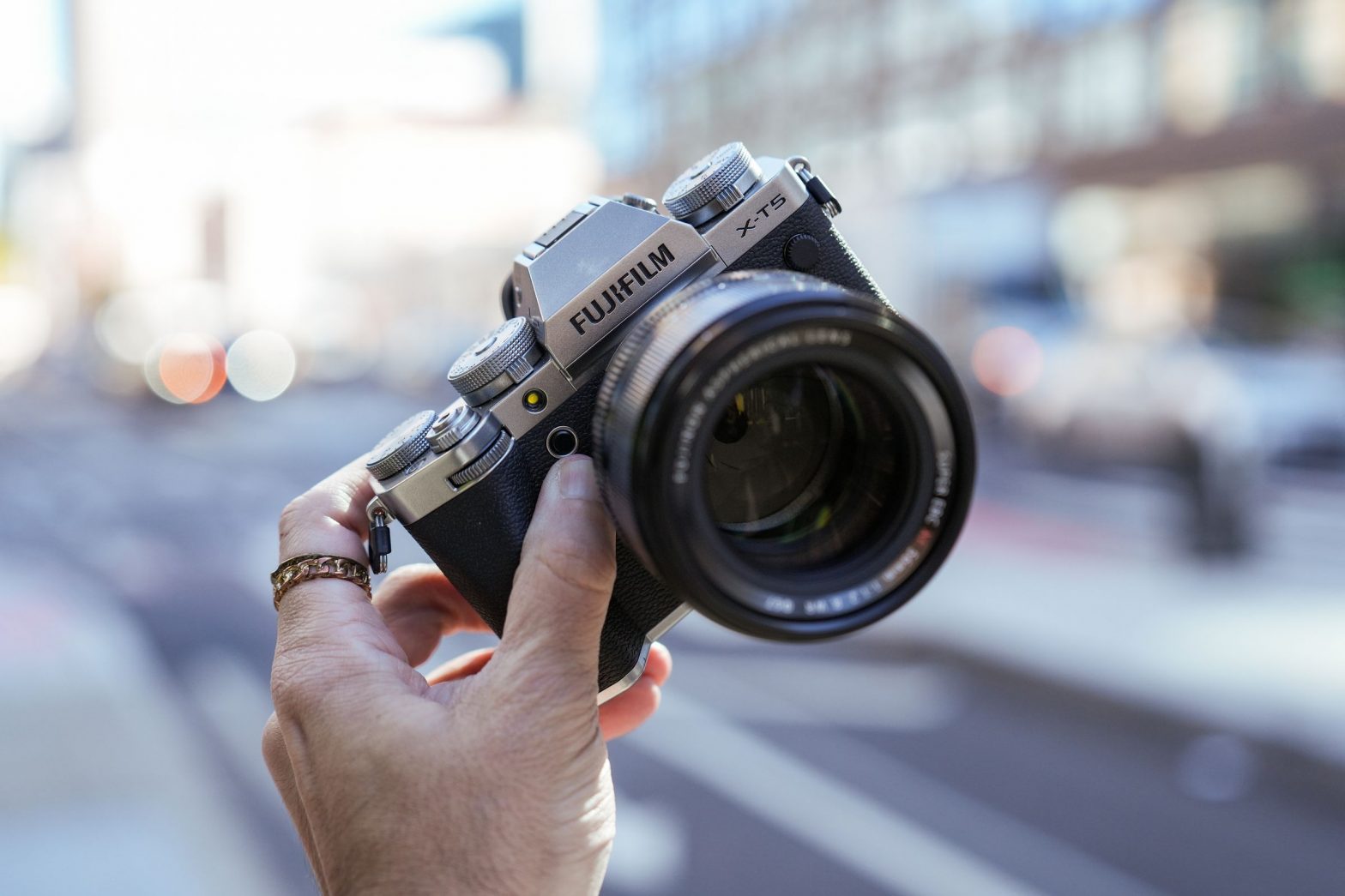/
The X-T5 adopts the 40-megapixel sensor of the pro-oriented X-H2 but at a size that’s close to the original X-T1. The $1,699.95 camera is aimed at photographers who want a small body with some big resolution.
:format(webp)/cdn.vox-cdn.com/uploads/chorus_asset/file/24161499/Fujifilm_X_T5_camera_ADiBenedetto_0001.jpg)
The new X-T5 mirrorless camera is a bit of an apology letter from Fujifilm to its fans, who disliked the video-focused features creeping into their favorite photo camera line. Where the X-T4 got a little bloated in size and featured a flip-out screen better equipped for video, the new X-T5 pares things down to put still-image capture at the forefront.
The X-T5 is smaller and lighter than the previous model, and it borrows the 40-megapixel APS-C sensor, fifth-gen X Processor, subject-detection autofocus, and seven-stop in-body image stabilization from the pro-oriented X-H2. This new camera costs the same as its predecessor, as it will sell for $1,699.95 for the body in silver or black when it launches November 17th. Alongside it is a new macro lens, the XF 30mm f/2.8 R LM WR Macro lens, that does 1:1 reproduction and will cost $599.95.
:format(webp)/cdn.vox-cdn.com/uploads/chorus_asset/file/24161506/Fujifilm_X_T5_camera_ADiBenedetto_0008.jpg)
The 40-megapixel APS-C backside-illuminated CMOS sensor from the X-H2 seems like the logical choice for this stills-first camera, as it prioritizes resolution over speed and video. The X-T5 can still record 4K video at up to 60p or oversampled 6.2K at 30p with this sensor, but that’s a far cry from the 8K-capable X-H2 or 4K at 120p potential of the X-H2S and its stacked sensor. There are other small compromises here in the X-T5, too, like an internal buffer that tops out at a burst of 19 RAW files — which is lower than the 35 RAWs of the X-T4 and a fraction of the X-H2’s 400-shot buffer. The X-T5 may share the same processor as the latest X-H cameras but it must be making some performance compromises for the sake of a compact body with a smaller internal cooling system.
Fujifilm made other conscious decisions to cater to photographers who favor the traditional street-style camera of older X-T models. Vlogging be damned, the X-T5 has gone back to the three-axis tiltable last found in the X-T3 — eschewing the fully articulating display of the X-T4 that’s more versatile for video. You can’t point the X-T5’s screen forward for self-recording, though Fujifilm deemed this trade-off worthy since it is faster to deploy for waist-level and above-the-head shots. While we’ve just seen how the new Sony A7R V achieves the best of both these worlds with its four-axis articulating display, the X-T5 opts for sticking with what’s familiar.
:format(webp)/cdn.vox-cdn.com/uploads/chorus_asset/file/24161500/Fujifilm_X_T5_camera_ADiBenedetto_0002.jpg)
:format(webp)/cdn.vox-cdn.com/uploads/chorus_asset/file/24161502/Fujifilm_X_T5_camera_ADiBenedetto_0004.jpg)
I got a brief hands-on with a preproduction X-T5, and the diet Fujifilm put the camera on is immediately noticeable. The new model is 30 grams lighter than the X-T4 and nearly the same dimensions as the original X-T1, though still thicker, which reverses Fujifilm’s trend of slowly growing these cameras with each iteration. It’s a return to form for the sake of lightness and portability, though the grip may once again feel too small for larger hands. Fujifilm will also sell an optional MHG-XT5 handgrip for $129.99, and I think it may be deemed an essential accessory for anyone who hates having their pinky finger floating in no-man’s-land. There won’t be a battery grip option this time around, though thankfully the battery capacity is a formidable 740 shots (CIPA rating). That’s about 140 shots more than the X-T4 with the same NP-W235 rechargeable battery and even slightly more than both the X-H2S and X-H2.
The X-T5’s electronic viewfinder is the same 3.69 million dots running at 100fps like the last-gen model, but it’s been improved with a slightly higher magnification of 0.8x and aspherical elements in the optics for a better view when your eye isn’t aligned dead-on. The EVF may not be pushing the most dots or refresh rate in the world, but it looked sharp and felt snappy. It reacts to your eye and switches the live view from the LCD a fraction of a second faster than the X-T4, but I always appreciate any marginal improvements like these.
:format(webp)/cdn.vox-cdn.com/uploads/chorus_asset/file/24161508/Fujifilm_X_T5_camera_ADiBenedetto_0010.jpg)
The autofocus of the X-T5 felt equally snappy, with fast continuous tracking being fairly sticky on moving subjects. I tried it with the XF 16–80mm f/4 kit lens and the excellent XF 56mm f/1.2 II portrait lens, and both optics nailed focus with relative ease. The X-T5’s eye-tracking autofocus still seemed prone to getting mixed up when there was a busy background behind a distant subject’s head, though I have seen other systems struggle in similar situations. The subject-detection autofocus of the X-H2 cameras, which tracks animals, birds, cars, bikes, airplanes, and trains is a welcome addition to the X-T5 — though be prepared for plenty of menu fiddling when switching between them or fine-tuning each one.
:format(webp)/cdn.vox-cdn.com/uploads/chorus_asset/file/24161509/Fujifilm_X_T5_camera_ADiBenedetto_0011.jpg)
While my time with the X-T5 was brief, I understand Fujifilm’s aim at course-correcting this product line for its diehard photo fans. Now that the X-H2 and X-H2S are available, Fujifilm feels comfortable letting the more demanding users who require better video choose one of those models. It may turn off some folks who still want this street-style camera to do everything for them, but Fujifilm seems to be betting that more of its fan base cares about small size and portability. That was one of the early prospects of mirrorless systems, and since then, most systems have ballooned in size for the sake of larger sensors and higher performance. The X-T5 is going to ask photographers to be okay with some trade-offs at the margins for the sake of the experience.
Photography by Antonio G. Di Benedetto / The Verge
